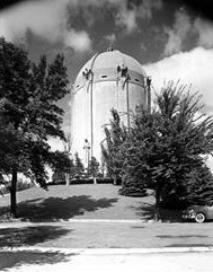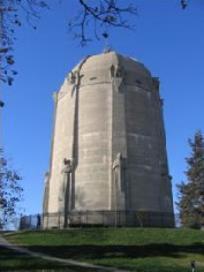Overview
The Washburn Park Water Tower combines the skills of three great professionals: architect Harry Wild Jones, engineer William S. Hewitt, and sculptor John K. Daniels.
- Location: 401 Prospect Avenue
- Neighborhood: Tangletown
| 1951 | 2006 |
|---|---|

|

|
The Washburn Park Water Tower combines the skills of three great professionals: architect Harry Wild Jones, engineer William S. Hewitt, and sculptor John K. Daniels.
| 1951 | 2006 |
|---|---|

|

|
The Washburn Park Water Tower combines the skills of three great professionals: architect Harry Wild Jones, engineer William S. Hewitt, and sculptor John K. Daniels.
The water tower was built on top of a hill in the Washburn Park area, today known as Tangletown. Many people moved to this neighborhood in the early 1900s and built houses. In fact, Harry Wild Jones designed his own house nearby.
Engineer William S. Hewitt had developed the “Hewitt System” of prestressed concrete tank construction. A concrete inner shell was poured first. The inner shell is reinforced by adjustable steel bands. Then a second layer of concrete was applied over the bands to protect them. The water tower is 110 feet tall and has a capacity of 1.35 million gallons.
Architect Harry Wild Jones designed the tower with a domed top. There are eight concrete ribs on the exterior. Each rib has two sculptures, done by John K. Daniels. Near the base, there are 18-foot-tall figures that represent health. They look like medieval knights. Near the base of the dome, there are eight-foot-tall eagles. Daniels also designed the milling figures on the Washburn Flour Mills Utility Building.
The water tower provided water pressure to the neighborhood until the 1990s. It is an artistic design for a utilitarian function.
Community Planning & Economic Development (CPED)
Phone
Address
Public Service Building
505 Fourth Ave. S., Room 320
Minneapolis, MN 55415